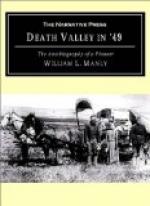I well remember that last night in camp before we started with our knapsacks and left the families, for it was plain the women and children must go very slow, and we felt we could go over rougher and shorter roads on foot and get through sooner by going straight across the Sierra Nevada Mountains. Our condition was certainly appalling. We were without water, all on the verge of starvation, and the three poor cattle which yet remained alive were objects of pity. It seemed almost a crime to kill the poor beasts, so little real food was there left on their skeleton frames. They had been so faithful and had plodded along when there seemed no hope for them. They might still serve to keep the party from starvation.
It was at this camp that Mr. Ischam died. The night before our departure he came wandering into camp and presented such an awful appearance, simply a living skeleton of a once grand and powerful man. He must have suffered untold agony as he struggled on to overtake the party, starving and alone, with the knowledge that two of his companions had perished miserably of starvation in that unknown wilderness of rocks and alkali.
Our journey on foot through the mountains was full of adventure and suffering. On our arrival at the shores of Owen’s Lake not a man of the party had a mouthful of food left in his pack, and to add to our difficulties we had several encounters with the hostile Indians. There was a fearful snow storm falling at Owen’s Lake on the evening that we arrived there, and we could make no fire. The Indians gathered around us and we did not know exactly what to make of them, nor could we determine whether their intentions were good or bad. We examined the lake and determined to try to ford it, and thus set out by the light of the moon that occasionally peeped out from behind the clouds, while the red devils stood howling on the shore.
The following morning we found what was then known as the Fremont Trail, and by the advice of some friendly Indians who came into our camp, we kept the “big trail” for three days and came to Walker’s Pass. While on this trail we were followed at night by a number of wild Indians, but we prudently avoided any collisions with them and kept moving on. Going on through the pass we followed the right hand branch of the trail, the left hand branch leading more to the south and across a wide plain. We soon came to a fair-sized stream, now known to be the south fork of the Kern River, which we followed until we came to its junction with a larger river, the two making the Kern River. Here we were taken across by some friendly Indians who left the Missions farther west during the Mexican war and took to their own village located at the foot of the Sierra Nevada Mountains. At this village we were on exhibition for several hours with an audience of five hundred people or more, of the red men, and on the following morning we commenced the ascent of the mountains again, the Indians furnishing us with a guide in the person of an old Pi-Ute. He brought us over the range, through the snow and over the bleak ridges, in the month of December, 1849, and we made our first camp at an Indian village in Tulare Valley, a few miles south of where Porterville now stands.




